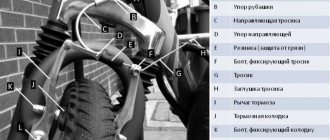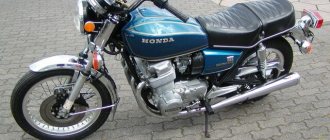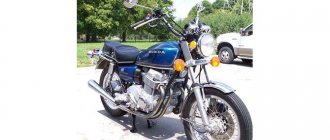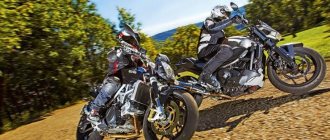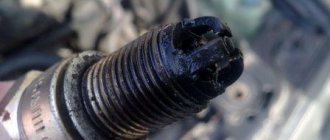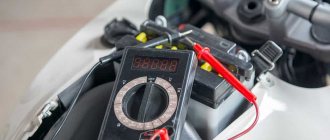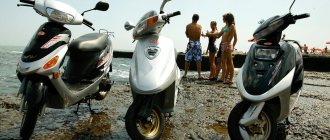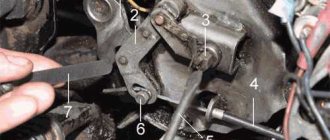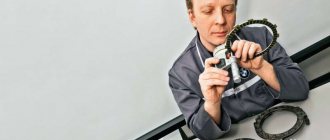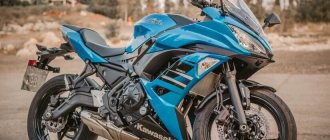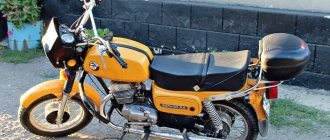It doesn't matter if it's a heavy cruiser, an enduro or a mild-mannered tourer - every meter counts in this situation! We advise you on how to brake your motorcycle safely and effectively and how to properly adjust the brake system.
Braking on a motorcycle
Citizen Kovalskaya drives carefully because she was in an accident twenty years ago. Today started out badly for her - her neighbors flooded her apartment early in the morning! Moreover, her child was unbearable in the morning, and his guardian was more than a quarter of an hour late! As a result, a crazy and furious Kowalskaya gets into the car and rushes to work. As she leaves the main street, she looks left and right out of the corner of her eye. And he doesn’t notice the oncoming motorcyclist...
If you are a motorcyclist, then prayer is not enough. You only have a few seconds to avoid a collision with a car that suddenly appears in your way. In a split second, you must make a decision - stop or try to avoid a collision.
What is the reason for emergency braking? We will explain this using the example of the Honda 1000 CBF. To show all stages of braking as accurately as possible, all changes and even the slightest errors, we equipped Honda with a set of electronic sensors and a data recording system. We measured everything from the hydraulic pressure in the brake systems, through the suspension movements, to the skidding of the front wheel and thus recognizing the tendency of the wheels to lock.
Braking on a motorcycle
What factors influence braking?
- Wheel grip. A major factor influencing all maneuvers, including turning and braking. The better the grip, the more stable the motorcycle will be and the faster it will respond to steering.
- Contact patch. This is the area of grip on the road. The larger it is, the easier it is to brake.
- Wheel load. Proper braking requires that the wheel that bears the heaviest load is used. This can be either the front or rear wheels.
About the myth about “I put the motorcycle down”
You can often hear a phrase in the style of “I realized that I didn’t have time to brake, so I put the motorcycle down.” It is all a lie, from beginning to end. In an emergency situation, only reflexes and the instinct of self-preservation are triggered. There cannot be any conscious analysis about whether you have time to slow down or not. Therefore, in order for the reflexes to work correctly, it is necessary to regularly practice emergency braking on the site. Many times.
Now about “put the motorcycle down”. Any bike brakes better on two wheels, with rubber adhering to the asphalt, using both brakes - than in an uncontrolled flight on its side, sliding plastic and metal along the road, without any grip on the surface.
- If a fall occurs, you and your motorcycle will fly into an obstacle at the same speed at which you fell;
- If you tried to brake until the last moment, you have a chance to reduce the speed enough to make a subsequent maneuver and avoid a collision, or if you fail to dodge, you will collide with an obstacle at minimum speed, your chances of staying alive and not even getting hurt are increase significantly;
- If there are pedestrians ahead, a bike flying at the same speed on its side crashes into their legs, which leads to multiple fractures and a strong blow to the head on the asphalt, with a wide amplitude. The maximum speed reduced by proper braking, even if it leads to a collision, the consequences will be much less serious, perhaps even just a slight jolt.
Therefore, everyone who says that “I realized that I didn’t have time to brake, and therefore I put the motorcycle down” - stop lying and looking for excuses for yourself. It’s better to enroll in a good motorcycle school, where they will teach you how to brake properly.
How does the braking system work?
Before we figure out how to brake properly, let's find out how the motorcycle braking system works. It uses friction to slow down the moving parts of the mechanism: roughly speaking, the brake pads clamp the disc. Most modern bikes use a disc system, with drum brakes installed on the rear on some cruisers and smaller models. The brake drive can be hydraulic or mechanical.
The main requirement for modern braking systems is not at all an increase in the force that the pads exert on the disc, but a minimum weight and high sensitivity of the motorcycle brakes. At the same time, the stiffness of the fork and tires affects the performance of the braking system. Since friction is the basis of braking, pads are made from materials that are resistant to abrasion and high temperatures: copper, brass, lead, carbon, Kevlar and graphite. Cast iron or stainless steel are used to make discs; carbon fiber discs are installed on racing motorcycles.
Although drum brakes are now a rarity, historically they were the first type of braking system. The main element is the drum, inside of which there is a braking mechanism. Because the drum is enclosed, the heat generated when the disc slows down is not dissipated, and the brakes quickly overheat.
Disc brakes are open, they rotate with the wheel. Adjacent to the disc is a caliper that contains pistons or pads. When you press the handle, the pistons move and the pad is pressed against the disc. On modern motorcycles, the front wheel is equipped with two discs, and the rear wheel has one. This is due to the fact that when braking, more than half of the bike's weight is on the front wheel.
ENGINE STARTING
Starting the scooter engine is not difficult. The driver is required to turn the key to the “ON” position - the ignition will turn on. Press either brake lever and then the electric starter button to start the engine. Why do the instructions only require the engine to be started when the scooter is on the center stand? If it is on wheels, and the driver or an onlooker standing nearby inadvertently turns the throttle, the device will drive away, or at best, fall and scratch the lining.
After starting a cold engine, do not fuss; let it idle for a few minutes. This is not a ritual before the road (like “Let’s sit down, friends ...”), but a necessity: an unheated engine runs with “dips”, reacts sluggishly to gas or even stalls. While the engine is warming up, look around the dashboard to see if everything is in order: is there enough gasoline in the tank, is the red oil level light on (for two-stroke engines). If it lights up, the oil must be added immediately: there will be no second warning - the engine will seize.
If the engine does not start (which happens with older scooters), you will have to look for and eliminate the cause. You can't push start a scooter.
Front and rear brake performance
When braking, the center of gravity moves from one wheel to another, so up to 70% of the force should be on the front brake, and only 30% on the rear. It is easier to lock the rear wheel, but more difficult to lock the front wheel, which creates the risk of losing control. Therefore, you need to brake with both brakes at once, switching to a downshift.
Models with a short wheelbase stop mainly with the front wheel, cruisers and choppers - with the rear, but this does not eliminate the need to use rear and front discs at the same time. If you only apply the front brake, the rear wheel will leave the ground and you will tumble forward. If you press only the rear disc or drum, the motorcycle will skid.
Each motorcycle's brakes function differently, so before heading out on the road you need to check them in a free area. Evaluate the pressure applied and the brake combination. Correct braking technique: apply pressure to the rear wheel, then smoothly apply pressure to the front brake handle. The length of the braking distance will depend on the force of pressing. Close the gas before you hit the brakes, do not push the steering wheel. When stopping, straighten your arms to shift your center of gravity back.
Motorcycle controls
Location of motorcycle controls
They control the motorcycle using the steering wheel, levers and pedals, as well as electrical buttons and switches. The location of the controls on the steering wheel is identical for all motorcycles : on the right is the rotary throttle control handle (gas handle) and the front brake lever, on the left is the clutch lever.
Location of motorcycle controls :
Using the throttle handle, you control the speed (in common parlance - revolutions) of the crankshaft of a motorcycle engine . To increase them, turn the throttle handle toward you; when the handle is released, the spring returns it to the idle position. By pulling the clutch lever to the steering wheel with your fingers, it disconnects the engine from the transmission, and with the front brake lever, you brake the front wheel of the motorcycle . To apply the rear brake, press the pedal located near the right footrest with your right foot.
Some motorcycles also have a decompressor drive lever and a rotary lever (shifter) of the enrichment device installed on the steering wheel. The decompressor facilitates starting by communicating the cylinder combustion chamber with the atmosphere. It is driven by a cable connected to a lever on the steering wheel. Some foreign motorcycles have a mechanism for automatically turning on the decompressor when starting with a kick starter.
The enricher lever (also called a fuel corrector; on foreign motorcycles it is designated Choke ) connects the lever on the steering wheel with a cable to the mixture enrichment system in the carburetor. This system is used when starting a cold motorcycle when a richer mixture is required. On many motorcycles, the starter enricher is activated by a lever mounted directly on the carburetor.
The fuel valve, which controls the supply of gasoline to the engine, is located under the fuel tank. It has three positions in which: the main fuel supply is turned on (On); Reserve enabled; fuel supply is turned off (Off).
The ignition switch is most often located on the dashboard or in the headlight housing. Different key positions correspond to the activation of various circuits in the electrical system (On, Off, Park) or the steering wheel lock (Lock). On the steering wheel handles there are buttons and switches for the electrical system: on the right - a light switch, an electric starter button (if provided) and an emergency engine switch (Stop); on the left is a switch for direction indicators and headlights (high-low) with a horn button.
The foot start lever for a motorcycle (kick starter) can be located either on the right (all foreign motorcycles ) or on the left. When starting the engine, press it down vigorously with your foot.
The gear shift lever is located on the left side of the engine or gearbox (if it is made in a separate housing from the engine). The order of gear shifting on all motorcycles is the same: 1st gear - lever down, all others - up. To engage each gear, the driver presses the shift lever all the way. Only engaging neutral gear ("neutral"), in which the engine is decoupled from the transmission, requires a "half" shift of the lever. Modern foreign motorcycles have 5 gears (less often 6) and one “neutral” (between 1st and 2nd gears); most Russian (as well as Czech, Ukrainian and Belarusian) have 4 gears.
Motorcycle control instruments are located on the dashboard in the driver’s field of vision. These include: speedometer, tachometer, coolant (oil) temperature indicators, fuel quantity, battery charge. In addition, the lamps on the instrument panel indicate a low battery, low oil pressure or insufficient oil quantity; about turning on: high beam headlights, “neutral” in the gearbox, direction indicators. The speedometer shows the speed of the motorcycle , the tachometer shows the rotation speed of the motorcycle engine .
Source
Normal braking
Normally, a motorcycle overcomes the braking distance by loading the rear wheel. In this case, stopping efficiency is approximately two times lower than using the front one, because the contact patch at the front is larger and the center of gravity moves forward. However, applying the braking impulse rearward allows you to brake safer and better than if only the front disc is used. Therefore, normally a motorcycle brakes like this: the rider applies the rear brake, then smoothly presses the front. The stopping speed is controlled by the force of pressing the lever.
The first attempt must be successful
When a truck traveling in the opposite direction suddenly prevents you from overtaking, there is no time to think. The first try must be successful, because if not, then... ABS is here to help you! At full speed and with the brakes pressed all the way, the Honda CBF 1000 develops a speed of 9.5 m/s2 (braking distance 162.5 m). Because braking distance increases with the square of speed, the Honda CBF 1000 does not require double the 100 km/h (40 m) braking distance, but a full 122 m more.
Our test #3 is to detect differences in braking performance based on different friction coefficients. So it's about checking what braking feels like when driving on a slippery asphalt section or, for example, broken gravel on a road. This situation is extremely challenging. Hard braking at a speed of 100 km/h after a 20-meter remission, only to be erased again after 3 meters of gravel - this is the task we set for the test riders.
After slipping on the first try, the driver releases the brakes 14m, about 11m further than necessary. As a result, the braking distance increases to 48.7 m. What does ABS do? Just a few meters past a patch of gravel where the wheels briefly slide, the brake is applied so that the rear wheel is momentarily lifted off the ground. Honda stops after 45 m.
Emergency braking
Ideally, you should always brake as described above: rear brake - shift - front brake - shift. But in practice, there may not be time to maintain the correct technique. In emergency situations, many bikers slam on the front brakes, causing up to 90% of the bike's weight to shift forward. This is a potentially dangerous situation, and even in emergency situations it is best to use both brakes, squeezing them alternately or supplementing the front brake with the rear.
A faulty motorcycle will likely behave unpredictably during an emergency stop or a sharp decrease in speed. Therefore, it is important to punctually service the bike, lubricate the racks, and adjust the lever.
Using the brake when starting to go uphill
When going uphill (at the beginning of movement, from a standstill), you must hold the rear brake, while your left leg rests on the surface. If the road surface is slippery (water, sand, gravel), then at the same time hold the front brake with the rear one, since the weight of the motorcycle shifts to its rear. We begin to move up the hill with the brakes pressed. When we feel that the engine is loading, we release the rear brake, the fork begins to load (compression occurs). After this, smoothly release the front brake lever. If you suddenly release the brakes, there is a high probability that the motorcycle will roll over.
Complex braking
Complex equipment is used even in emergency cases, when it is impossible to avoid an accident, but it is necessary to minimize its consequences. However, remember that you cannot brake while turning. Before starting a turn, be sure to reduce your speed and go through the turn with slight acceleration. In an emergency situation, you should not press the brakes before completing the maneuver, otherwise you will lose stability and control, and an accident is guaranteed to occur.
On a slippery road with poor grip, they also brake with the front and rear discs, but you need to take into account that the motorcycle’s braking distance increases approximately five times. In addition, the risk of loss of control increases, so you need to stabilize the movement and squeeze the brake almost until the wheels lock.
Learning to brake properly takes time and experience. We recommend practicing the technique in an empty area. Finally, choose a motorcycle with anti-lock braking system - this is the safest and easiest option to ride.
20% more effective after 30 minutes
And test No. 4, the last one – complex braking. You often hear the statement that folding and braking at the same time are incompatible. It is not true! Depending on external conditions (including the temperature affected by the tires, and therefore the grip), in a Honda CBF 1000, slope 35 output a delay of 8 m/s2 can be obtained. Only an experienced rider can make such a difference under hard braking.
This type of braking should only be used when there is no other way to avoid an accident. Then even the slightest slip of the front wheel can turn into a skid. And this means his departure to the side, with all the ensuing consequences. And, in addition, the rider sometimes fights the tendency to get up from a slope.
Our series of tests allows us to conclude that without studying braking with maximum deceleration, you can’t get anywhere. As a consolation, we have the information that the secrets of this art are easy to master. Half an hour of training was enough for each of the three bikers taken from the street to reduce the braking distance to 20%. More important than their own successes, they all acknowledged that they understood how their safety depended on the laws of physics and where it ended.
IN TURNINGS
A very important warning: before entering a turn, you should complete the braking - this is an axiom. If the turn is smooth, then most often it’s enough just to let off the gas - the scooter will slow down a little. Although the CVT does not transfer braking force from the engine to the wheel when the throttle is closed, there is still some resistance in the transmission, plus the scooter's rolling resistance and aerodynamic drag will slow it down.
When entering a turn, mentally outline the trajectory of movement - a smooth curve with a maximum radius. If the speed is exceeded and, as a result, the scooter is tilted excessively, the grip of the tires will not be enough to hold the car - and a fall will occur. So, cornering at a moderate speed along the maximum radius will allow you to tilt the body less, which means that the grip of the tires on the road will remain quite high.
The most common position of the body relative to the scooter is when the tilt of the body is equal to the tilt of the machine. Other options: when the body tilt is greater or less than the scooter's tilt angle.
The first method is classic, this is how most scooter and motorcyclist riders ride, and this alone says that it is best suited for normal conditions.
Tilt of the body at an angle less than the tilt of the scooter allows you to make a turn along a minimum radius. The method is used for fast maneuvering at low speed.
The “body tilted more than the scooter” option is rarely used. In this case, the reserve of tire grip on the surface is far from exhausted (thanks to the special profile, tread pattern and tire composition), and it is impossible to tilt the vehicle to a greater angle. In addition to the body, the leg bent at the knee is extended to the side (this style is called “turning with the knee”). And sometimes the driver moves from the seat cushion to the inside of the turn. The technique is used for sports driving, but not on public roads.
The specificity of scooters with a CVT transmission affects maneuvering at low speeds. When the driver releases the gas, the scooter continues to move by inertia. When leaning towards the turn, the center of gravity moves towards the inside of the turn. In this case, the steering wheel turns in the same direction to compensate for the tilt. On motorcycles with a gearbox, in which the transmission provides a “rigid” connection between the wheel and the engine crankshaft, the driver slightly adds gas, which instantly causes acceleration and the appearance of centrifugal force, compensating for the overturning moment. In scooters, when the gas is increased, the V-belt variator and centrifugal clutch do not engage immediately, but with some delay. An experienced scooter driver goes through a turn without releasing, but rather accelerating. If it is necessary to reduce the speed, the brake is used, but not the throttle is released “to zero” speed: the driver must be sensitive to the device and create tension so that the transmission does not disconnect the wheel from the motor, and if necessary, the gas should be slightly increased.
Wheel stall
There is no need to speculate for a long time regarding wheel failure. In general, wheel slip is a side effect of corner braking. In fact, this same phenomenon can actually be called “drift,” it’s just that drift is not always caused by the action of the brake. The emergency braking is so abrupt that you feel as if your wheel has actually been torn off. When you just enter a turn, the front wheel often breaks off, since its angle of inclination does not correspond to the vector of movement of the entire motorcycle. But when exiting a turn, the rear wheel suffers, since most of the motorcycle has almost left the maneuver, and the rear wheel did not have time to change lanes after it.
Emergency braking is very dangerous in corners because you have to either maneuver or brake. And when you break this rule and press the brake, but try to steer, the wheel locks or the steering axle turns sharply to the side, the tire’s grip is reduced to zero and you simply fly head over heels along the highway.
How to brake correctly and safely on a motorcycle?
Ride a motorcycle
Ride a motorcycle
Braking a motorcycle is a complex element of riding technique that can lead to skidding and an accident.
The ability to brake a motorcycle is often the thin line between life and death. Imagine yourself riding your favorite two-wheeler. Cruising pace, no madness. You enter the blind right corner. In the center of the arc you see a slowly moving farm tractor. Truck in reverse direction. During your driving courses, you were taught the only open truth - never use your front brake when cornering! So what are you doing?
